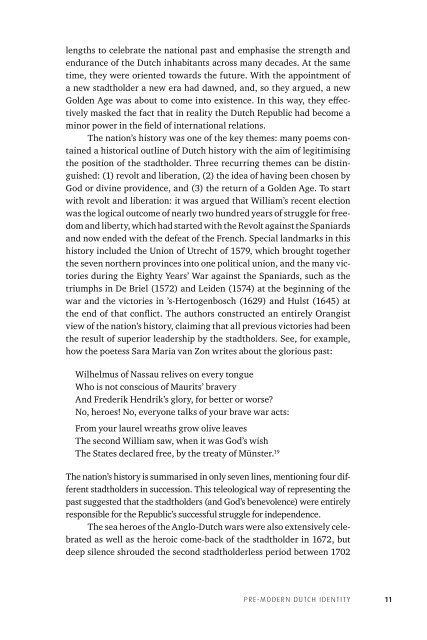Discord Consensus
7aze300jFJo
7aze300jFJo
You also want an ePaper? Increase the reach of your titles
YUMPU automatically turns print PDFs into web optimized ePapers that Google loves.
lengths to celebrate the national past and emphasise the strength and<br />
endurance of the Dutch inhabitants across many decades. At the same<br />
time, they were oriented towards the future. With the appointment of<br />
a new stadtholder a new era had dawned, and, so they argued, a new<br />
Golden Age was about to come into existence. In this way, they effectively<br />
masked the fact that in reality the Dutch Republic had become a<br />
minor power in the field of international relations.<br />
The nation’s history was one of the key themes: many poems contained<br />
a historical outline of Dutch history with the aim of legitimising<br />
the position of the stadtholder. Three recurring themes can be distinguished:<br />
(1) revolt and liberation, (2) the idea of having been chosen by<br />
God or divine providence, and (3) the return of a Golden Age. To start<br />
with revolt and liberation: it was argued that William’s recent election<br />
was the logical outcome of nearly two hundred years of struggle for freedom<br />
and liberty, which had started with the Revolt against the Spaniards<br />
and now ended with the defeat of the French. Special landmarks in this<br />
history included the Union of Utrecht of 1579, which brought together<br />
the seven northern provinces into one political union, and the many victories<br />
during the Eighty Years’ War against the Spaniards, such as the<br />
triumphs in De Briel (1572) and Leiden (1574) at the beginning of the<br />
war and the victories in ’s-Hertogenbosch (1629) and Hulst (1645) at<br />
the end of that conflict. The authors constructed an entirely Orangist<br />
view of the nation’s history, claiming that all previous victories had been<br />
the result of superior leadership by the stadtholders. See, for example,<br />
how the poetess Sara Maria van Zon writes about the glorious past:<br />
Wilhelmus of Nassau relives on every tongue<br />
Who is not conscious of Maurits’ bravery<br />
And Frederik Hendrik’s glory, for better or worse?<br />
No, heroes! No, everyone talks of your brave war acts:<br />
From your laurel wreaths grow olive leaves<br />
The second William saw, when it was God’s wish<br />
The States declared free, by the treaty of Münster. 19<br />
The nation’s history is summarised in only seven lines, mentioning four different<br />
stadtholders in succession. This teleological way of representing the<br />
past suggested that the stadtholders (and God’s benevolence) were entirely<br />
responsible for the Republic’s successful struggle for independence.<br />
The sea heroes of the Anglo-Dutch wars were also extensively celebrated<br />
as well as the heroic come-back of the stadtholder in 1672, but<br />
deep silence shrouded the second stadtholderless period between 1702<br />
Pre-modern Dutch identity 11


